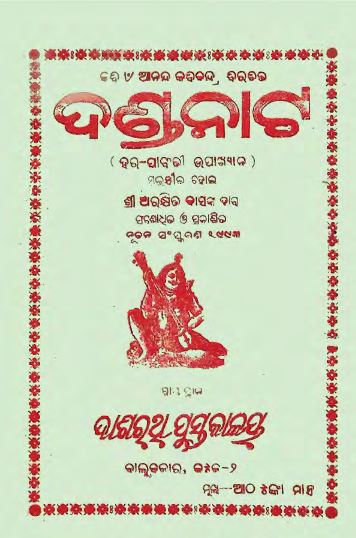Dandanata, a poignant literary work by the celebrated writer Anand Kabichandra, was published in 1993. This remarkable book is an exquisite fusion of lyrical poetry and profound spiritual insight, encapsulating the enchanting love story between Lord Shiva and Goddess Parvati. Renowned for his artistry, Kabichandra crafts a series of evocative sub-chhandas that not only illuminate the divine union of these celestial beings but also resonate with the emotional odyssey experienced by mortals in their pursuit of love and devotion.
The title “Dandanata” translates to “The Dance of Destiny,” a fitting metaphor to describe the intricate interplay of fate, love, and spirituality that unfolds within the verses. The work draws heavily from the age-old lore surrounding Shiva and Parvati, bringing their divine romance to life in a manner that captivates readers’ imaginations and hearts alike.
Kabichandra’s use of the sub-chhanda form—the specific rhythmic and lyrical pattern found in Odia poetry—enhances the reading experience, enveloping readers in a melodic flow that mirrors the grace and beauty of the deities. This structure provides a unique platform for the poet to delve into the multiple facets of love and devotion, juxtaposing the intoxicating bliss of union with the poignant sorrow of separation.
The narrative arc of “Dandanata” encapsulates the journey of Parvati, who undertakes immense trials and tribulations to win the heart of Shiva. Her unwavering determination and passion are vividly portrayed through rich imagery, symbolizing the strength inherent in devoted love. The poet skillfully illustrates her struggles, reflecting the soul’s yearning for union with the divine and the intrinsic desire that binds spirituality and romantic love.
In contrast, the portrayal of Shiva embodies tranquility, wisdom, and the raw, untamed aspects of nature. His persona is multifaceted—both the ascetic who renounces worldly attachments and the passionate lover who eventually succumbs to Parvati’s unwavering devotion. Through lyrical evocations, Kabichandra highlights this dichotomy, emphasizing how love transcends the barriers of the material and spiritual realms.
While “Dandanata” is enriched with the themes of love, the book also serves as a meditation on deeper philosophical concepts. The relationship between Shiva and Parvati symbolizes the essential union of masculine and feminine energies, representing a holistic view of existence. Their dance—an allegory for the cosmic play—offers insights into the balance of creation and destruction, coexistence and harmony, thereby imparting wisdom that transcends time and culture.
Dandanata stands as a profound literary accomplishment that intricately weaves together the threads of mythology, love, and spirituality. Anand Kabichandra’s lyrical prowess illuminates the eternal dance of Shiva and Parvati, making their divine romance relatable to readers across generations. The book not only captivates with its poetic beauty but also invites introspection on the nature of love, devotion, and the profound connections that bind humanity to the divine.
In celebrating the timeless narrative of “Dandanata,” readers are encouraged to reflect on their own journeys of love and faith, inspiring a richer understanding of the divine connections that exist within themselves and the cosmos. Through its eloquent sub-chhandas and thematic depth, “Dandanata” remains a cherished work in Odia literature, echoing the eternal dance of life, love, and destiny.
Books Info
| Books name | Dandanata |
| Author | Anand Kabichandra; A Das |
| No Of pages | 77 |
| Publisher | Dasarathi Pustakalaya |
| Publication | 1993 ne. |
| Printed At | NA |
| Distributor | NA |

